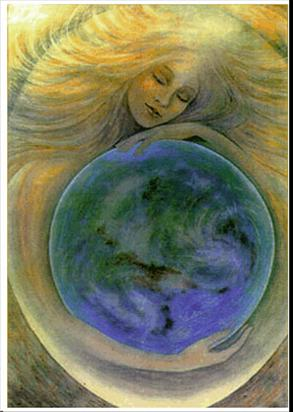Sophia

Goddess of Wisdom
by Rainsong
In language, wisdom started out as feminine in the Hebrew word hokhma, the Greek word sophia, and the Latin word sapienta. Wisdom became a neuter gender to the Greeks, called Pneuma, personified as a dove, the animal strongly associated with Sophia. As language moved to a more masculine expression of God, so did the image of Goddess move, from a vibrant creatrix to a passive adjunct or receptacle for the male seed. (Tate, 100)
In her role as feminine divine, Sophia is woven into goddess tradition over much of the world. She appears to have emerged as a central figure in the Christian philosophical movement called Gnosticism, likely originating in ancient Rome and Persia, a mystical sect embracing individual realization of the divine through ecstatic inner experience . This alone tells us much of the nature of Sophia: she is the inner knowing, rather than the knowledge gained from the outside world.
In judeo-christian traditions (Old Testament), Sophia is the beginning, the source of wisdom, known as the Mother of All, the female aspect of God. It is felt that Sophia is the woman represented in God’s embrace in Michelangelo’s painting on the ceiling of the Sistine Chapel:
The
creation story unfolds with Sophia desiring to make something of her own,
whereupon she fashions her son, Ialdabaoth, who in turn, creates the material
world. Here comes the sweet part of the
story, the part that drew me to Sophia:
“Sophia so desperately loved humans that she decided she would live
among them. To her dismay they mostly
ignored her. She tried speaking to
them. When they turned a deaf ear, she
screamed from the tops of the highest walls.
Still she was not heard. In her
anguish at being so neglected, she left humans with one last thought: You have
denied and ignored me, so will I do when calamity strikes and you call for my
help. Only those who earnestly search
for me and love me will merit my love and assistance.” (www.goddessgift.com)
She
has been tied to the worship of Mary and the Black Madonna, and other goddesses
associated with her include Athena, Minerva, Tara, and Innana.
Colors
associated with Sophia are red and radiant white, and temples dedicated to her
include the Hagia Sophia in Istanbul, Turkey, and the Saint Sophia Greek
Orthodox Church in Los Angeles. Though
the first exists as a museum now, the second is being shared by devotees of
Goddess spirituality as forms of Eastern Christianity retain a place for the feminine
aspect of God. Sophia also appears as
Shekinah in the mystical tradition of Kabalah.
(Tate 100)
What
is it that draws present day devotees to this Goddess? Judy Chicago represented Sophia in her Dinner
Party in the form of a single flower on a plate, the white center of the flower
being the original nature of the goddess of wisdom and the fullness of her
creative strength, then, as the petals fade, the power wanes, and strength
pales as the downfall of goddess spirituality progressed....Perhaps we are
moved to reclaim the deep experiencing of our own woman-wisdom and the rightful
place of that wisdom in structuring a new world. Here I have written a ritual
to reconnect and respect our own insight.
fresh
bendable branches from a willow tree, about 3 feet long
thin
wire used in floral arranging
ribbons
many
white candles
The
women form a circle, singing the song, “We All Come from the Goddess,” and the
directions are called in.
We welcome the spirits
of the north, spirits of Earth, may you guide our footsteps and support us.
We welcome spirits of
the east, spirits of air, may you offer us the gentle winds of inspiration
We welcome spirits of
the south, spirits of fire, may you burn away that which keeps us from
ourselves
We welcome spirits of
the west, spirits of water, may you bathe us in wisdom and in love
We welcome the spirit
of center, the goddess Sophia, may you guide us to our inner wisdom and to
trusting ourselves as the wise women we are
Each
woman takes a willow branch, and begins to peel away the bark, as she does so,
peeling away that which keeps her from her inner knowing.
I
peel away and discard those masks I wear to please society, to please others, I
peel away and discard self-deprecation, feelings of unworthiness, mistrust and
judgement.
Each
woman lights the white candles, affirming a part of herself she wishes to bring
to blossoming, what I create has value to myself and to others, I trust myself
in love and in relationship, I am capable of healing myself and others.
SOPHIA

Shrieking
with delight at her own power,
she
gave us all that is,
humankind
with all its foibles, its glories, its baseness,
she
held out her hand,
we
brushed it away
thrilled
with our own freedom to choose
we broke her soft
surfaces with our sharp edges, blasted away her spiny ridges, covered her
breath with concrete
inexorably rolling
towards our own destruction, sacrificing lives to ideas, forcing steely
separation between man and woman, woman and man
She
wept, disconsolate.
She
raised her waters, her winds, in fury, with a promise to those who loved her to
return.
So she comes, wisdom
in all its radiance, a dove of peace, vibrant, alive, dancing to the chants of
the women who gather to honor her light.
Bright
Blessings,
Rainsong
Painting
of Sophia embracing earth:
http://northernway.org/presentations/godwife/1.html (Permission granted
for use 1/26/2010)
Painting
of Sophia in Sistine Chapel as well as Sophia’s story
www.goddess-gift.com/goddess-myths/sophia-goddess-wisdom.htm
Tate,
Karen. Sacred Places of Goddess 108 Destinations. USA, Consortium of Collective Consciousness,
2006.
http://www.brooklynmuseum.org/eascfa/dinner_party/place_settings/
sophia.php Elizabeth A. Sackler Center for Feminist
Art, The Dinner Party, Place Setting: Sophia